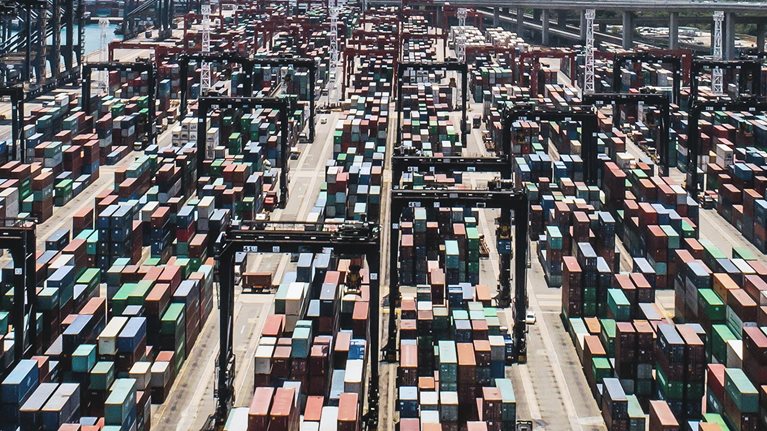The COVID-19 crisis has disrupted production and logistics activities across the world, leaving many organizations struggling with uncertain delivery times and critical shortages of parts and materials. Recent shortages of semiconductors, lumber, and steel are a reminder of how vulnerable today’s globally integrated supply chains can be—and of technology’s strategic value in revealing potential disruptions along the n-tier supply chain.
The pandemic may have pushed supply chains to the top of the corporate agenda, but the topic was already on the rise. Ambitious environmental, social, and governance (ESG) targets require original-equipment manufacturers (OEMs) and suppliers to track, manage, and communicate data on their carbon emissions and labor practices across all tiers of their supplier networks. And, with suppliers responsible for 80 percent of total product value in industries such as automotive, supplier cost, quality, innovation, and delivery performance remain critical to business success.
Companies know that closer collaboration with their suppliers is a powerful way to drive improvement across all these dimensions. But the vision of a truly integrated supply chain has proved difficult to realize. OEMs and suppliers seeking to increase data sharing and collaboration across their supply networks have faced three principal hurdles.
Technology. The current technologies used to exchange data between supply-chain participants tend to be relatively unsophisticated. The electronic data interchange (EDI) standard widely used in the automotive sector, for example, allows only limited information on forecasts, orders, and delivery schedules to be shared between two companies.
Operating model. Participants have not yet developed standards for the exchange of more complex data, from the carbon footprint of parts to the real-time location of products as they move through logistics networks.
Trust. Trust is an important issue for participants from two perspectives. First, some data is considered too sensitive to share with external partners. Second, participants often lack a common understanding of the value or accuracy of one another’s data. That makes it difficult for organizations to agree on the terms and incentives for data sharing projects. And it can make them reluctant to integrate external data into their own management and planning systems.
The value of integration
In one McKinsey survey of more than 100 large organizations in multiple sectors, companies that regularly collaborated with suppliers demonstrated higher growth, lower operating costs, and greater profitability than their industry peers. To offer a more granular view of the potential impact of highly integrated supply chains, we modeled the supply chains of one major industry: the automotive sector. The car industry provides an informative test case because its supply chain is complex, and industry players have already worked hard to drive efficiency and squeeze out waste to increase their usually-low margins.
Our analysis took a deliberately narrow view of the supply chain, looking at the potential efficiency gains generated through the integration of day-to-day activities: supply-chain planning and execution, logistics planning and execution, and quality management. We modeled the impact of integration across the end-to-end value chain from “tier-n” suppliers through vehicle OEMs to dealers, including the role of the logistics-service providers that manage and execute the flow of materials, components, and finished vehicles (Exhibit 1).

Would you like to learn more about our Operations Practice?
For the global automotive industry, we found that integrating those activities could save OEMs and their suppliers between €40 and €65 billion per year. At the 5 to 7 percent margin typical in the industry, that represents a 50 percent profitability boost.
The largest benefit we identified came from greater production efficiency at supplier sites. Integrated planning helps suppliers run stable operations, with fewer schedule changes, changeovers between products, and extra shifts. The process also works the other way. If upstream suppliers cannot meet a customer request, early warnings may allow downstream players to adjust their schedules, minimizing disruption and maintaining output. In our model, planning improvements accounted for €25 to €50 billion in benefits.
Another large benefit came from reducing inventories across the supply chain. High inventory levels are often the result of unreliable or uncertain forecasts, or lack of communication about production-schedule changes that will affect material call-offs in a just-in-time operating environment. Addressing these issues through collaborative, end-to-end planning could save the industry a further €6 to €8 billion on inventory costs, freeing up capital.
The third largest impact came from improvements in transportation efficiency. Increasing the overall utilization of transport assets and reducing the number of emergency deliveries is expected to save the industry €2 to €4 billion. Better transport utilization also improves the industry’s carbon footprint, allowing it to keep components flowing with fewer truck journeys and less airfreight.
Finally, integration would help companies manage quality in their production operations. Linking data on production process parameters, test results, and transport and storage conditions to parts as they move through the supply chain will aid the identification of quality issues, accelerate root-cause problem solving, and allow suspect parts to isolated when problems occur. In the automotive sector, that could be worth around €1-2 billion every year.
Building a truly integrated supply chain
How would organizations capture all this value? Our modeling is based on the introduction of systems that allow multiple data streams from supply-chain participants and external sources to be integrated in a single platform. That platform would be used to exchange demand forecasts, jointly optimize production and logistics schedules, and track operations and asset information in real time across the end-to-end value chain (Exhibit 2).

Beyond the technical challenges of establishing such a system, supply-chain participants also need to find a fair way to run it. The opportunities identified in our analysis cannot be captured by any single party operating alone; they require collaborative action by multiple players. Furthermore, the benefits of supply-chain integration initiatives don’t necessarily accrue to the organizations that put in the most work. Better medium-term forecasts and commitments for parts subject to highly variable demand help suppliers optimize their production capacity—but the cost of building and updating those forecasts falls to the OEM. To make such arrangements work, participants will want to align on a mutual and fair mechanism for the sharing of efficiency gains, while incentivizing the information exchange for both parties.
A data-governance and operating model to facilitate successful data-based collaboration includes awareness on the relative value of data internally and for partners, the ability to manage data along its lifecycle (consistent ontology, data quality assurance), the ability to extract value through application and analytics (analytics capabilities, use-case identification), and the ability to share data securely and stay in control (data-sharing standards).

Can your supply chain deliver what your consumer wants?
The technology is ready
Many companies are already using technology and analytics internally as part of their Industry 4.0 vision. The requirements of Fourth Industrial Revolution implementations have, to a large extent, been mapped to solutions for most of the technology challenges. The technology stack for the Internet of Things (IoT) platforms used to coordinate manufacturing operations is becoming well defined and widely used.
And a number of technology players provide systems that enable near-real-time sharing of data between entities and supply-chain partners. These cloud-based platforms can link to a wide range of IoT and enterprise resource-planning (ERP) systems, offering off-the-shelf solutions to data management, security, access rights, and control challenges. They also provide an environment in which participants can apply machine learning and advanced analytics tools to extract insights from shared supply-chain data.
Manufacturing players and software companies have developed the ability to create digital twins of components, complete machines, entire factories, and even supply-chain relationships—modeling all relevant parameters in near real-time. These digital twins contain all relevant data points and relations to model the production system and optimize its performance using analytics and artificial intelligence.
Recognizing the potential of these new technologies, several large manufacturers have started to implement cloud-based platforms to support internal Industry 4.0 developments and provide improved connectivity with suppliers, customers, and other stakeholders. In the automotive sector, several leading tier-1 suppliers have worked with OEMs to create joint platforms with the goal of supply-chain optimization. Likewise, players in the aerospace sector have developed systems used to share maintenance and asset-performance data throughout the value chain, through to asset owners and service providers.
Overcoming the barriers to collaboration
The development of suitable technologies has been an important step, but platforms alone are insufficient to enable deep integration between supply-chain participants. Industrial IoT platforms work nicely to drive efficiency within companies, but collaboration along the supply chain requires further enablers. For example, players will need to agree as to how those platforms will be used, align on standards for data exchange, agree on rights over data access and ownership, and establish common conventions for the naming of objects, products, and events in the supply chain. Moreover, since in many industries suppliers serve several customers, these standards and conventions should be as open as possible, so companies can easily integrate their own systems with those of multiple partners. Defining open standards for data exchange, as well as a joint ontology for data, is only just beginning and will mean close collaboration with technology and cloud providers.
To put the necessary infrastructure and standards in place, we foresee the need for a collaboration “orchestrator” within the supply chain. The orchestrator would work with supply-chain participants to foster agreement on appropriate standards and protocols, and build the digital platform for data exchange. In some supply chains, such as in the automotive industry, the OEM might perform this orchestrator role, using its scale and strong relationships with tier-1 suppliers to do the heavy lifting required to get digitally enabled supply-chain collaboration off the ground. In other sectors, the orchestrator could be a third party, funded or supported by multiple OEMs and major suppliers.
A supply-chain technology orchestrator can help in overcoming technology and resource challenges— but they may not be able to resolve the trust issue. Where the orchestrator is also a major customer in the supply chain, other participants may be concerned about sharing sensitive data. And where the value created by integration projects is to be shared among participants, suppliers need to be confident that calculated improvements are derived from accurate data and a fair baseline.
In cases such as these, supply participants may wish to appoint a “trustee”—an impartial third party that can review potentially sensitive data from multiple participants and help them establish equitable incentive arrangements. Modern technologies such as blockchain or homomorphic encryption may provide the necessary toolkit to run a cross-industry data-sharing platform while ensuring trust from all parties involved.
Steps towards impact
Solving the inherent challenges of supplier collaboration is always a bilateral discussion, requiring a joint understanding of the potential and commitment to closer collaboration. Such efforts require a first mover to initiate the discussions, however. This could be a leading OEM, a major player elsewhere in the market (perhaps one facing significant cost pressure), or a group of like-minded stakeholders.
We see a clear separation between first assessing the impact at stake and the required capabilities, and then building the technology infrastructure and governance to realize the potential. To prepare, a company can take several initial actions that are largely under its own control.
- Identify leading suppliers within its own supply chain and the products or components with optimization potential (ideally components of high value, high demand fluctuation, and high criticality for the manufacturing process).
- Engage with suppliers to identify today’s largest pain points, and potential data-driven solutions.
- Pinpoint critical enablers for realizing the potential, such as the exact data that needs to be shared, the data’s cyclicality, the required level of data protection, and the types of analytics that are needed.
- Synthesize and generalize use cases so that they form a scalable platform, with common data formats, standards, ontology, and interfaces that enable it to be extended readily to other use cases and suppliers.
- Define the platform’s operating model and governance structure, creating data-sharing mechanism and clarifying critical roles, such as those of the platform orchestrator and operator and the data-sharing trustee (if needed to protect highly sensitive data).
If participants can work together to overcome barriers—including common operating standards, trust, and appropriate gain sharing—they could significantly reduce costs and improve resilience. Greater integration will also serve as basis for an end-to-end focus on sustainability. It is one key enabler for the fast, flexible, sustainable and efficient supply chain of the future.


